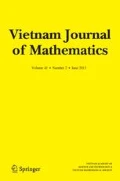Abstract
We study a shadow limit (the infinite diffusion coefficient-limit) of a system of ODEs coupled with a semilinear heat equation in a bounded domain with Neumann boundary conditions. In the literature, it was established formally that in the limit, the original semilinear heat equation reduces to an ODE involving the space averages of the solution to the semilinear heat equation and of the nonlinearity. It is coupled with the original system of ODEs for every space point x. We present derivation of the limit using the renormalization group (RG) and the center manifold approaches. The RG approach provides also further approximating expansion terms. The error estimate in the terms of the inverse of the diffusion coefficient is obtained for the finite time intervals. For the infinite times, the center manifolds for the starting problem and for its shadow limit approximation are compared and it is proved that their distance is of the order of the inverse of the diffusion coefficient.
We’re sorry, something doesn't seem to be working properly.
Please try refreshing the page. If that doesn't work, please contact support so we can address the problem.
References
Bobrowski, A.: Singular perturbations involving fast diffusion. J. Math. Anal. Appl. 427, 1004–1026 (2015)
Carr, J.: Applications of Centre Manifold Theory. Springer, New York (1981)
Chen, L.Y., Goldenfeld, N., Oono, Y.: RenorMalization group theory for global asymptotic analysis. Phys. Rev. Lett. 73, 1311–1315 (1994)
Chen, L.Y., Goldenfeld, N., Oono, Y.: Renormalization group and singular perturbations: multiple scales, boundary layers, and reductive perturbation theory. Phys. Rev. E 54, 376–394 (1996)
Chiba, H.: C 1 approximation of vector fields based on the renormalization group method. SIAM J. Appl. Dyn. Syst. 7, 895–932 (2008)
Chiba, H.: Extension and unification of singular perturbation methods for ODEs based on the renormalization group method. SIAM J. Appl. Dyn. Syst. 8, 1066–1115 (2009)
Chiba, H.: Reduction of weakly nonlinear parabolic partial differential equations. J. Math. Phys. 54, 101501 (2013)
Gray, P., Scott, S.K.: Autocatalytic reactions in the isothermal continuous stirred tank reactor: isolas and other forms of multistability. Chem. Eng. Sci. 38, 29–43 (1983)
Lee DeVille, R.E., Harkin, A., Holzer, M., Josić, K., Kaper, T.: Analysis of a renormalization group method and normal form theory for perturbed ordinary differential equations. Physica D 237, 1029–1052 (2008)
Gierer, A., Meinhardt, H.: A theory of biological pattern formation. Kybernetik 12, 30–39 (1972)
Hale, J.K., Sakamoto, K.: Shadow systems and attractors in reaction-diffusion equations. Appl. Anal. 32, 287–303 (1989)
Haragus, M., Iooss, G.: Local Bifurcations, Center Manifolds, and Normal Forms in Infinite-Dimensional Dynamical Systems. Springer Universitext (2011)
Henry, D.: Geometric Theory of Semilinear Parabolic Equations. Lecture Notes in Mathematics, vol. 840. Springer (1981)
Hock, S., Ng, Y., Hasenauer, J., Wittmann, D., Lutter, D., Trumbach, D., Wurst, W., Prakash, N., Theis, F.J.: Sharpening of expression domains induced by transcription and microRNA regulation within a spatio-temporal model of mid-hindbrain boundary formation. BMC Syst. Biol. 7, 48 (2013)
Keener, J.P.: Activators and inhibitors in pattern formation. Stud. Appl. Math. 59, 1–23 (1978)
Klika, V., Baker, R.E., Headon, D., Gaffney, E.A.: The influence of receptor-mediated interactions on reaction-diffusion mechanisms of cellular self-organization. Bull. Math. Biol. 74, 935–957 (2012)
Ladyzenskaja, O.A., Solonnikov, V.A., Ural’ceva, N.N.: Linear and Quasi-linear Equations of Parabolic Type. Translations of Mathematical Monographs Reprint, vol. 23. American Mathematical Society, Providence (1968)
Lengyel, I., Epstein, I.R.: A chemical approach to designing Turing patterns in reaction-diffusion systems. Proc. Natl. Acad. Sci. USA 89, 3977–3979 (1992)
O’Malley, R.E. Jr.: Singular Perturbation Methods for Ordinary Differential Equations. Applied Mathematical Sciences, vol. 89. Springer, New York (1991)
Marciniak-Czochra, A., Härting, S., Karch, G., Suzuki, K.: Dynamical spike solutions in a nonlocal model of pattern formation. arXiv:1307.6236 [math.AP] (2013)
Marciniak-Czochra, A., Karch, G., Suzuki, K.: Unstable patterns in reaction-diffusion model of early carcinogenesis. J. Math. Pures Appl. 99, 509–543 (2013)
Marciniak-Czochra, A., Kimmel, M.: Modelling of early lung cancer progression: influence of growth factor production and cooperation between partially transformed cells. Math. Models Methods Appl. Sci. 17, 1693–1719 (2007)
Marciniak-Czochra, A., Kimmel, M.: Reaction-diffusion model of early carcinogenesis: the effects of influx of mutated cells. Math. Model. Nat. Phenom. 3, 90–114 (2008)
Murray, J.D.: Mathematical Biology. II. Spatial Models and Biomedical Applications, 3rd edn. Interdisciplinary Applied Mathematics, vol. 18. Springer, New York (2003)
Moise, I., Ziane, M.: RenorMalization group method. Applications to partial differential equations. J. Dyn. Differ. Equ. 13, 275–321 (2001)
Temam, R., Wirosoetisno, D.: On the solutions of the renormalized equations at all orders. Adv. Differ. Equ. 8, 1005–1024 (2003)
Tikhonov, A.N., Vasil’eva, A.B., Sveshnikov, A.G.: Differential Equations. Translation of: Differentsial’nye Uravneniiya. Springer, Berlin (1985)
Vasil’eva, A.B., Butuzov, V.F., Kalachev, L.V.: The boundary function method for singular perturbed problems. SIAM, Philadelphia (1993)
Ziane, M.: On a certain renormalization group method. J. Math. Phys. 41, 3290–3299 (2000)
Acknowledgments
Andro Mikelić would like to express his thanks to The Heidelberg Graduates School HGS MathComp, IWR, Universität Heidelberg, for partially supporting his post-Romberg professorship research visits in 2014-2015. Anna Marciniak-Czochra acknowledges the support of the Emmy Noether Programme of the German Research Council (DFG).
Author information
Authors and Affiliations
Corresponding author
Additional information
This contribution is dedicated to Professor Willi Jäger on his 75th birthday. Multiscale analysis and biological applications are two subjects of focus in Willi’s research over his professional life.
Rights and permissions
About this article
Cite this article
Marciniak-Czochra, A., Mikelić, A. Shadow Limit Using Renormalization Group Method and Center Manifold Method. Vietnam J. Math. 45, 103–125 (2017). https://doi.org/10.1007/s10013-016-0199-6
Received:
Accepted:
Published:
Issue Date:
DOI: https://doi.org/10.1007/s10013-016-0199-6

